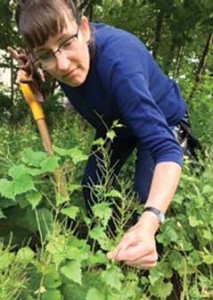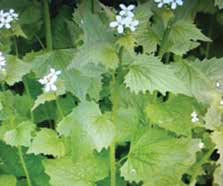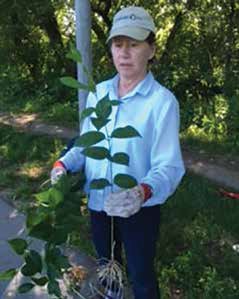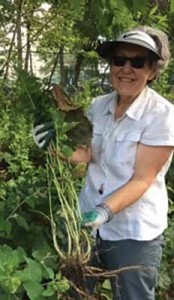ByTerry West
You may have seen these Old Ottawa Easterners on a Sunday morning. They’re the ones covered from head to toe for protection—tics, poison ivy—carrying shovels, plastic bags and working in the trees along the edge of the Rideau River. What they’re doing is rescuing the shoreline from the ravages of foreign-introduced, invasive species. The territory they concentrate on extends from the McIlraith Bridge to the LRT bridge, and the species getting most of their attention include dog- strangling vine, garlic mustard and, most familiar, burdock, that producer of pesky burrs that our pets drag home. Don’t hesitate to engage any of these folks in conversation. They’ll be only too happy to show you the plant bandits they’re after. There may even be some of them in your backyard that you’ve been anxious to identify and remove.
Invasive plant species have a lot of us confused. Some are downright attractive, begging the question, why bother trying to eliminate them? The Ontario Invasive Plant Council is very categoric on this: apparently, in the struggle for space, these introduced invasive plants don’t fight fair. Our native plants have insects, birds and animals harassing them at every turn. The invaders get off scot-free; they’re food for a few of our insects and beasts. Not only that, but these sneaky sons-of-guns excrete a toxin into the soil that kills off our home-grown heroes. They also reproduce like crazy—dog-strangling vine up to 30,000 seeds per square metre; garlic mustard 60,000. Left untouched these unwanted plants will completely take over fields and bushlands.
Chemicals once helped in the struggle, but they’re no longer permitted, leaving us with three choices—digging, cutting, smothering (see Invasive Species Information). Along with most homeowners, the OOE group prefers digging them up. No matter what method used they have a habit of coming back. But if you stick to it, large swaths of territory can be reclaimed.
Nothing is more encouraging than to see native plants and saplings beginning to reappear; proof that natural, vegetational health is on the rebound. This is the objective that fuels the efforts of OOE’s Invasive Species Eradication Team.
Backyard eradication is a huge help in the process. We’re all aware of how quickly unwanted varieties pop up under fences and across wide-open areas.
The OOE Invasive Species Eradication Team usually meets Sunday mornings from 8:30 to 10:30. Members include: Roger Bird, Paul Churcher, Karen Gravelle, Aileen Larkin, Phyllis Odenbach Sutton, Ian McRae, Ines Adriana Rojas Rios, Peggy West, Terry West.
OOE’s “Top 3″ Invasive Species
How To identify:
• Grows 1 to 2 metres (twines on plants)
• Oval leaves with pointed tips; leaves grow on opposite sides of stem
• Pink to dark purple star-shaped flowers grow before plant produces slender green, bean-shaped seed pods
How To remove (always before seed pods mature – late spring/early summer):
• Dig out as much of root cluster as possible
• Cutting or mowing prevents spread, but the plant will come back for 2 – 4 years
How To dispose:
• Place in a black plastic bag and dispose in garbage, and never compost
How To identify:
• Young crushed leaves release garlic odour
• 2nd year plants produce white flowers with 4 small petals
• 2nd year plants grow up to 1 metre
• Narrow seed pods of 2.5 – 6 centimetres long split open in midsummer revealing tiny black seeds
How To remove (late spring):
• Dig up as much root as possible; or
• Smother under heavy plastic or newspaper
How To dispose:
• Place in a black plastic bag and dispose in garbage, and never compost
How To identify:
• In 1st year leaves are broad (15-46 cm in length) heart-shaped and grow close to the ground
• In 2nd year plant has small, prickly, purple-coloured, ball-shaped flowers and shoots up to 1-2 metres; flowers dry and become brown burrs
How To remove:
• When plant is small, dig out tap root (pull out if ground is moist).
• Cut/mow plant before it has bloomed
• Cut off whole stock in 2nd year; repeat for 1-4 years until root dies
How To dispose:
• Place whole stock in a leaf or black plactic bag and dispose in garbage; Never compost
Very Important
As all of the above are spread by seed, it is absolutely essential to remove the plants before the seeds ripen. Once ripened, gravity, wind, and movement of animals and humans assist in broadcasting them widely.
![]() If you feel strongly about the problem, please consider joining the group by contacting Karen Gravelle at: karen_gravelle@yahoo.ca. For further details on the general scope of the problem, or to answer specific questions go to the Ontario Invading Species Hotline: 1-800-563-7711; www.invadingspecies.com.
If you feel strongly about the problem, please consider joining the group by contacting Karen Gravelle at: karen_gravelle@yahoo.ca. For further details on the general scope of the problem, or to answer specific questions go to the Ontario Invading Species Hotline: 1-800-563-7711; www.invadingspecies.com.










